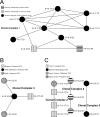Evaluation in Cameroon of a Novel, Simplified Methodology to Assist Molecular Microbiological Analysis of V. cholerae in Resource-Limited Settings
- PMID: 26735969
- PMCID: PMC4703203
- DOI: 10.1371/journal.pntd.0004307
Evaluation in Cameroon of a Novel, Simplified Methodology to Assist Molecular Microbiological Analysis of V. cholerae in Resource-Limited Settings
Erratum in
-
Correction: Evaluation in Cameroon of a Novel, Simplified Methodology to Assist Molecular Microbiological Analysis of V. cholerae in Resource-Limited Settings.PLoS Negl Trop Dis. 2016 Mar 8;10(3):e0004537. doi: 10.1371/journal.pntd.0004537. eCollection 2016 Mar. PLoS Negl Trop Dis. 2016. PMID: 26954780 Free PMC article. No abstract available.
-
Correction: Evaluation in Cameroon of a Novel, Simplified Methodology to Assist Molecular Microbiological Analysis of V. cholerae in Resource-Limited Settings.PLoS Negl Trop Dis. 2016 Mar 21;10(3):e0004573. doi: 10.1371/journal.pntd.0004573. eCollection 2016 Mar. PLoS Negl Trop Dis. 2016. PMID: 26999288 Free PMC article. No abstract available.
Abstract
Background: Vibrio cholerae is endemic in South Asia and Africa where outbreaks of cholera occur widely and are particularly associated with poverty and poor sanitation. Knowledge of the genetic diversity of toxigenic V. cholerae isolates, particularly in Africa, remains scarce. The constraints in improving this understanding is not only the lack of regular cholera disease surveillance, but also the lack of laboratory capabilities in endemic countries to preserve, store and ship isolates in a timely manner. We evaluated the use of simplified sample preservation methods for molecular characterization using multi-locus variable-number tandem-repeat analysis (MLVA) for differentiation of Vibrio cholerae genotypes.
Methods and findings: Forty-seven V. cholerae isolates and 18 enriched clinical specimens (e.g. stool specimens after enrichment in broth) from cholera outbreaks in Cameroon were preserved on Whatman filter paper for DNA extraction. The samples were collected from two geographically distinct outbreaks in the Far North of Cameroon (FNC) in June 2014 and October 2014. In addition, a convenience sample of 14 isolates from the Philippines and 8 from Mozambique were analyzed. All 87 DNAs were successfully analyzed including 16 paired samples, one a cultured isolate and the other the enriched specimen from which the isolate was collected. Genotypic results were identical between 15 enriched specimens and their culture isolates and the other pair differed at single locus. Two closely related, but distinct clonal complexes were identified among the Cameroonian specimens from 2014.
Conclusions: Collecting V. cholerae using simplified laboratory methods in remote and low-resource settings allows for subsequent advanced molecular characterization of V. cholerae O1. These simplified DNA preservation methods identify V. cholerae and make possible timely information regarding the genetic diversity of V. cholerae; our results set the stage for continued molecular epidemiological research to better understand the transmission and dissemination of V. cholerae in Africa and elsewhere worldwide.
Conflict of interest statement
The authors have declared that no competing interests exist.
Figures


References
-
- Chatterjee SN, Chaudhuri K (2003) Lipopolysaccharides of Vibrio cholerae. I. Physical and chemical characterization. Biochim Biophys Acta 1639: 65–79. - PubMed
Publication types
MeSH terms
Grants and funding
LinkOut - more resources
Full Text Sources
Other Literature Sources
Medical

